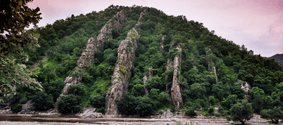Phulwari ki Nal Wildlife Sanctuary
| Phulwari ki Nal Wildlife Sanctuary | |
|---|---|
 Phulwari ki Nal Wildlife Sanctuary | |
 Phulwari ki Nal Wildlife Sanctuary  Phulwari ki Nal Wildlife Sanctuary | |
| Location | Kotra tehsil and Jhadol tehsil, Udaipur district, Rajasthan, India |
| Nearest city | Udaipur, Rajasthan |
| Coordinates | 24°12′54″N 73°14′43″E / 24.2150223°N 73.245354°ECoordinates: 24°12′54″N 73°14′43″E / 24.2150223°N 73.245354°E |
| Area | 511.41 km2 (197.46 sq mi) |
| Established | 1983 |
| Governing body | Rajasthan State Forest Department |
Phulwari ki Nal Wildlife Sanctuary is located in Udaipur District of Rajasthan, in the southern Aravalli Hills bordering the state of Gujarat.[1] It was declared a Wildlife Sanctuary on October 6, 1983, by the Government of Rajasthan.[2][3]
Geography
The area of the Phulwari ki Nal Wildlife Sanctuary is 511.41 km2.,[4] of which 365.92 km2 is Reserved Forest and 145.49 km2 is Protected Forests.[5] The sanctuary is spread over Kotra and Jhadol tehsils of Udaipur district.[2] There are 134 villages present inside the sanctuary.[2] Elevation of the terrain within the sanctuary varies from 600–900 m above MSL.[6] The climate in the sanctuary is classified as semi-arid, with an annual rainfall of 730 mm.[6][5]
Wildlife
Wild animals observed in the Phulwari ki Nal Wildlife Sanctuary include flying squirrel,[7] three-striped palm squirrel, mouse deer,[8] panther,[9] leopard, hanuman langur, Indian peafowl, jungle cat, Bengal fox, golden jackal, striped hyena, grey junglefowl, and green whip snake.[1]
Facilities
The Phulwari ki Nal Wildlife Sanctuary is administered out of headquarters located in Kotra, Udaipur District, Rajasthan.[2] There are three rest houses located inside and around the sanctuary, at Mamer, Panarwa, and Kotra.[2]
References
- 1 2 Sharma, B.K.; Kulshreshtha, Seema; Rahmani, Asad R. (2013). Faunal Heritage of Rajasthan, India: Conservation and Management of Vertebrates. Springer Science & Business Media. p. 37. ISBN 9783319013459.
- 1 2 3 4 5 "Annual Plan of Operations for Phulwari-ki-Nal Wildlife Sanctuary For The Year 2007-2008" (PDF). Retrieved March 4, 2017.
- ↑ "Rajasthan State Notification F11 (1) Revenue / 8 / 83 dated 6 October 1983" (PDF). Retrieved 24 December 2017.
- ↑ Kankane, P.L. (2000). Status Survey of Chinkara and Desert Cat in Rajasthan (PDF). Calcutta: Zoological Survey of India. p. 45. ISBN 81-85874-30-1.
- 1 2 "Assessment of Biodiversity in Phulwari-ki-Nal Wildlife Sanctuary: A Conservation Perspective" (PDF). Foundation for Ecological Security. March 4, 2017.
- 1 2 Sharma, Satish Kumar (1996). "Amphibians of Phulwari Ki Nal Wildlife Sanctuary". Journal of the Bombay Natural History Society. 92: 271–272.
- ↑ Koli, Vijay Kumar; Bhatnagar, Chhaya; Sharma, Satish Kumar (January–February 2013). "Distribution and Status of Indian Giant Flying Squirrel (Petaurista philippensis Elliot) in Rajasthan, India". National Academy Science Letters. 36: 27–33.
- ↑ Ecological Profile Gogunda, Rajasthan (PDF). Foundation for Ecological Security. 2017. p. 28.
- ↑ Mathur, Ashok (7 February 2018). "Panthers are entering cities. Question is whether to kill or save them?". Udaipurblog.com. Retrieved 10 June 2018.
Further reading
- Banu, Farhat; Sharma, Satish Kumar (2016). "A Note on Bryophytic Flora of Certain 'Nals' of Phulwari Wildlife Sanctuary" (PDF). Indian Journal of Environmental Sciences. 20 (1&2): 53–57. Retrieved 10 June 2018.
- Satish Kumar, Sharma (2017). "Identifying sites for promoting ecotourism in Phulwari-ki-nal Wildlife Sanctuary (PWLS), Southern Aravalli Hills of India". IIOAB Journal. 8 (1): 15–21.